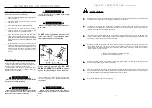
11
10
S A F E T Y I N S T R U C T I O N S
(continued)
Comply with state and local laws governing highway safety and movement of farm machinery on public roads.
The use of flashing amber lights is acceptable in most localities. However, some localities prohibit their use.
Local laws should be checked for all highway lighting and marking requirements.
When driving the tractor and equipment on the road or highway under 20 mph (32 kph) at night or during the
day, use flashing amber warning lights and a slow moving vehicle (SMV) identification emblem.
Always be sure the implement is in the proper raised position for transport.
Reduce speed when transporting mounted implements to avoid bouncing and momentary loss of steering
control.
Plan your route to avoid heavy traffic.
Always install transport locks, pins or brackets before transporting.
Do not drink and drive!
Watch for traffic when operating near or crossing roadways.
Turn curves or go up or down hills only at a low speed and at a gradual steering angle. Make certain that at
least 20% of the tractor’s weight is on the front wheels to maintain safe steerage. Slow down on rough or
uneven surfaces, and loose gravel.
Use extreme care and maintain minimum ground speed when transporting on hillside, over rough ground and
when operating close to ditches or fences. Be careful when turning sharp corners.
Never allow riders on either power unit or implement. Falling off can kill.
Be a safe and courteous driver. Always yield to oncoming traffic in all situations, including narrow bridges, inter-
sections, etc.
Do not exceed 20 mph (32 kph). Reduce speed on rough roads and surfaces.
Always disengage PTO before driving the tractor to transport the implement from one place to another.
TRANSPORT SAFETY
S A F E T Y I N S T R U C T I O N S
(continued)
Good maintenance is your responsibility. Poor maintenance is an invitation to trouble.
Follow good shop practices.
- Keep service area clean and dry.
- Be sure electrical outlets and tools are properly grounded.
- Use adequate light for the job at hand.
Make sure there is plenty of ventilation. Never operate the engine of the towing vehicle in a closed building.
The exhaust fumes may cause asphyxiation.
Before working on this machine, drive to a level area, disengage the PTO, lower implement or loader (or if
working underneath, raise and block securely), shut off the engine, relieve all hydraulic pressure, set the
brakes, and remove the ignition keys.
Be certain all moving parts on attachments have come to a complete stop before attempting to perform
maintenance.
Never work under equipment unless it is blocked securely. Never depend on hydraulic system to keep imple-
ment in raised position.
Always use personal protection devices such as eye, hand and hearing protectors, when performing any
service or maintenance.
Keep all persons away from operator control area while performing adjustments, service, or maintenance.
Periodically tighten all bolts, nuts and screws and check that all cotter pins are properly installed to ensure unit
is in a safe condition.
When completing a maintenance or service function, make sure all safety shields and devices are installed
before placing unit in service.
Openings in the skin and minor cuts are susceptible to infection from hydraulic fluid. If injured by escaping
hydraulic fluid, see a doctor at once. Gangrene and death can result. Without immediate medical treatment,
serious infection and reactions can occur.
MAINTENANCE SAFETY
























